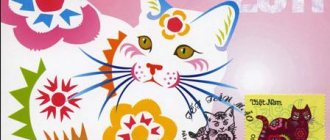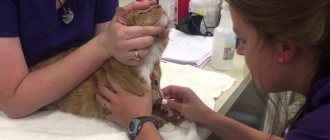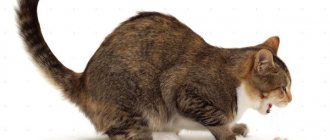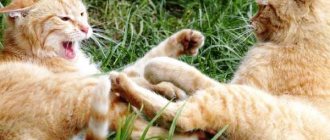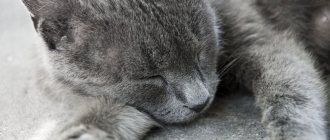Probably the most interesting and curious character in world literature is the Cheshire Cat. This hero amazes with his ability to appear and disappear at the most unpredictable moments, leaving behind only a smile. No less interesting are the quotes from the Cheshire Cat, which amaze with their unusual logic and make you think about many questions. But this character appeared much earlier than the author wrote him into the book. And it’s quite interesting where the author got the idea for it.
Why is the cat smiling?
The Cheshire Cat was created by Lewis Carroll for the book Alice in Wonderland. It is noteworthy that in the first version of the story this character was absent and appeared only in 1865. Most likely, its appearance is due to the expression “the smile of the Cheshire Cat”, popular at that time. And this saying has two common versions of its origin. The author of the book himself was born and raised in Cheshire, and it was there that it was fashionable to paint lions above the entrance to taverns. But since no one saw these predators, they were given the appearance of toothy and smiling cats.
The second version is as follows: cheese wheels in the shape of smiling cats were produced in Cheshire and were popular throughout England. But what does the smile of the Cheshire Cat mean? There is still ongoing debate on this issue. Some philologists believe that this is still connected with cheese. Others dispute, saying that at that time even cats laughed at the “high” title that the county of Cheshire, which was a provincial province with a small size, ascribed to itself.
Character Description
Lewis Carroll's book says that the Cheshire Cat is a constantly smiling creature that quickly disappears or appears at will. The cat is also given the ability to teleport. Sometimes he disappears, but his smile continues to “hang” in the air. In other cases, only the Cheshire Cat's eyes remain, and his head and body are not visible. Disney animators depicted all the “transformations” of the beast in great detail.
Many people remember the hero's appearance from the character who was presented in the 1951 Disney cartoon. In this painting, the artists gave the Cheshire Cat a unique appearance - he has a striped body, a pair of yellow crazy eyes and a wide smile.
The viewer can also remember some of the character's aphorisms from the film. We are given to understand that the Cheshire cat is partly a philosopher, entertaining Alice and other characters with his difficult phrases.
The Endangered Cat (Cheshire)
In addition to the smile, there is another equally interesting skill of this character - to dissolve and materialize in the air at will, but where did the author get this idea? At one time there was a legend about the Congleton cat: one fine day the abbess's favorite disappeared, but a few days later the nun heard a familiar scratching sound.
Opening the door, she saw her beloved cat, who at that very moment disappeared into thin air. Since then, this ghost has been seen by many visitors to the abbey. Lewis Carroll himself was known for his penchant for mysticism and was probably impressed by this story, which he embodied in his character.
Character Quotes
The Cheshire Cat makes memorable sayings:
“He who seeks will always find... If he seeks correctly.”
“Joy and slavery do not live together under the same roof.”
“Everyone in our world is crazy.”
“Stupid does not mean ignorant.”
These and other wisdom of the character can be found by looking into the work of Lewis Carroll or watching the film of the same name. What does each of them mean? You can talk about their meaning for a long time, but everyone understands the meaning in their own way.
Cheshire Cat Country
Surely it would not be a lie to call Wonderland the kingdom of the Cheshire Cat. After all, from the first meeting in the Duchess’s kitchen, this character accompanied Alice. Moreover, he was her mentor and helped her get out of difficult and absurd situations, despite the fact that his dialogues with Alice did not always bring her pleasure, and sometimes were quite annoying. The philosophical questions that the Cheshire Cat loved to ask confused Alice, but, after thinking a little, she found a way out of situations thanks to them. His expressions have long been dissected into quotes, which are used to emphasize the absurdity of situations.
Character
These are very gentle, sweet creatures . They don’t raise their voices without a reason, but when they want something, they can be heard very well. Compared to their ancestors, the Persians, they are more energetic and love outdoor games. Exotics are very smart, not at all aggressive . They allow children to play with them, but only one family member is considered the owner. They hate loneliness and get along well with other animals in the house .
Important! Exotics are very vulnerable. Appreciate their love, caress and play with them more often. Cats get sick from lack of attention.
Character character
When reading the book, most readers got the impression that this character is quite friendly and nice. And indeed it is. The Cheshire Cat has some inexplicable charm despite the fact that he prefers a solitary life. He is optimistic, cheerful and will always come to the rescue in difficult times.
But at the same time, the cat is selfish and never admits his guilt due to stubbornness. He is extremely irritable and impulsive, due to which he can commit unseemly acts that he will regret in his soul, but will not admit to it. He is vain and a little crafty, although he himself cannot stand lies. His attitude towards himself is especially interesting, because the Cat considers himself crazy only because he is surrounded by crazy people. In general, this is the most contrasting and inimitable character in world literature.
Origin story
The path to officially breeding these hybrids was started by Jane Martink .
She insisted that the Association of Domestic Cat Breeders, as well as the CFA, recognize them as a new breed and allow them to perform at exhibitions. This happened in 1966. The breed was originally called sterling, which means silver of the highest standard . The cats were gray in color. But then they renamed it exotic, since the new color had not previously been seen in short-haired cats.
1967 was a year of success and victories for the new breed of cats. One of them won the status of champion . The highest award legitimized the existence of exotics officially.
In 1987, the CFA legalized the crossing of American Shorthair cats only with Persians. All other crossing options are considered illegal.
Sometimes an exotic cat's litter will include a long-haired kitten . This is due to a recessive gene that is responsible for long hair. These kittens were long considered a waste, but in 2010 they received the right to be considered a separate breed, an exotic longhair cat, although they were previously called the longhaired version of the shorthaired Persian cat.
Culture and the Cheshire Cat
This hero has long acquired a cult reputation, and his image is used by many authors in their works, for example, Jeff Nuna, Andrzej Sapkowski, Jasper Fforde, Frank Beddor. The Cheshire Cat has gained enormous popularity in such an art form as anime. There are also a large number of comics with his participation. Recently, tattoos depicting the Cheshire cat have gained popularity.
But still, the most interesting images of the character were embodied in the adventures of Alice. The popular Disney cartoon, released in 1951, introduces this cat as an intellectual with a mischievous personality who is sometimes classified as one of Disney's villains. In a computer game about Alice's adventures in a Wonderland spoiled by nightmares called Alice Madness Returns, this hero appeared before us in the form of a thin cat with tattoos, but continues to act as a travel guide and, with his quotes, makes the main character think about the events.
We saw another remarkable Cheshire Cat in the film adaptation of Alice's adventures from Tim Burton. Although he was a computer character, he was still remembered for his half-screen smile and tireless zeal to give useful advice. This hero had elegance, calmness and impressiveness, as well as the ability to hide cowardice under a seductive smile. His ability to get out of ridiculous situations was demonstrated at the moment when the Hatter accused the cat of running away when the Red Queen seized the throne. But thanks to his talents and skills, Cheshire was rehabilitated among his friends and made amends.
Care
The American Shorthair gave the exotics excellent health , but the Persians slightly corrected it, passing on their weak physical aspects.
These are watery eyes, snoring during sleep due to a flattened nose, and deformed teeth. Breeders of these animals say that these cats are for the lazy . They require virtually no maintenance. But some procedures will still have to be carried out daily or several times a month:
- Rinse eyes daily.
- Bathing . No more than once a quarter. During the molting period, 1-2 times a month.
- Trimming nails . Purchasing a claw point will make this task easier.
- Combing . You need to scratch your cat once a week. Exotic wool is prone to matting and requires regular careful grooming.
- It is necessary to dry the animal after bathing . The undercoat takes a long time to dry, and the animal may catch a cold.
- to remove worms from short-haired exotics regularly, once every three months.
Important! Proper feeding of the animal will ensure it has beautiful fur and no health problems. It is not recommended to feed exotics with human food.
Mystery of origin
In those distant times in England, one of the common expressions was the phrase “the smile of a Cheshire cat.” And perhaps she pushed Carroll to create the character. This theory is confirmed by the fact that the phrase meant a sarcastic and ironic smile, characteristic only of the “Cheshire” cat. It is noteworthy that such a breed of domestic animal has never existed. Then how did everyone know about them? Historians have several theories about the origin of the “Cheshire” cats:
- In Cheshire, where Carroll was from, it was fashionable to paint lions and leopards on tavern signs. But since none of the artists had ever seen these predators, they ended up with big smiling cats.
- According to the second theory, the phrase appeared due to the fact that little Cheshire was always proud of his title, which “even the cats laughed at.”
- According to the third theory, the expression became widespread because of the wheels of cheese that the county sold throughout England. They were round with large holes, reminiscent of a cat's face.
The meaning of tattoos for men
The Cheshire cat is not even really a cat, but a creature “on his own mind.” This sage is inclined to philosophize, puzzle his interlocutor and leave on time “in English.”
The ability to carry yourself with self-esteem under any circumstances and disappear without a trace when the situation demands it, wisdom and the ability to avoid conflicts - these are the qualities demonstrated by men who choose a Cheshire tattoo.
Such men prefer to negotiate (and they know how to do this!), and they will not use physical force without a reason.
The Cheshire cat tattoo for men symbolizes:
- Wisdom and philosophical mindset;
- Cheerfulness and unconditional optimism;
- Flexibility, the ability to find a way out of any situation;
- Sense of humor, resourcefulness.
Causes of itching
Owners do not always immediately begin to sound the alarm when they discover scratching on their pet. Often they believe that this is not a very serious problem. If the scratching is minor and the itching does not particularly bother the cat, the owner can completely ignore this problem. But it is worth remembering that many diseases are curable only in the first stages. Therefore, it is important to promptly find out the cause of itching and provide professional help to your pet.
Lichen
This is an extremely contagious fungal disease that is also dangerous for humans. It is easily transmitted from a sick animal to a healthy one through short bodily contact, or even through grooming items (combs, nail clippers). Without timely treatment, lichen in dogs, like in cats, can lead to serious consequences for the health of the animal.
You might be interested in: Why do my cat's ears turn red inside?
The main symptoms of lichen infection:
- The coat appears unhealthy. A large number of broken hairs.
- Small bald spots appear, which the cat actively scratches. They can be found primarily on the head, neck and paws.
- Hard crusts appear on bald spots.
- Lost fur grows back very slowly.
- Dandruff appears on the skin.
- In the final stages, purulent lesions form.
Skin parasites
Fleas are a very common parasite, especially among cats that have free access to the outdoors. Fleas are quite dangerous, because their bites lead to a decrease in the animal’s immunity. The cat becomes vulnerable to various bacteria and fungi. Flea bites cause severe itching, causing the animal to constantly scratch. Particularly sensitive cats may scratch their skin until it bleeds.
Your cat can also pick up ticks, lice and coccidia. However, the animal does not have to go outside for this. The owner may well bring some parasites with him on shoes and clothes.
The main symptoms of infection with skin parasites:
- deterioration in the appearance of fur;
- severe itching;
- anxiety;
- fleas and ticks can be seen visually if you look closely at the animal’s skin.
A tick bite can lead to quite serious consequences. At the same time, the animal’s temperature may rise, loss of appetite, and decreased activity.
It is best to consult a veterinarian to remove a tick. If the procedure is performed incorrectly, parts of the tick may remain in the animal's skin, which can cause a purulent abscess to form.
Allergy
An allergic reaction can occur completely unexpectedly in any cat. Most often, animals suffer from food allergies. It often manifests itself when changing the diet or adding new foods to it. Food allergies are the easiest to identify and therefore easy to combat.
But when diagnosing non-food allergies, problems can arise. In this case, it is not always possible to determine which allergen caused the body’s negative reaction.
An allergic reaction can be caused by:
- individual food products (often chicken and milk);
- pollen and plant parts;
- flea and tick bites;
- various chemical elements contained in cleaning products and perfumes;
- dust.
Otitis
Otitis of the external ear is a serious disease that can cause many problems for the animal. Infection of the ear canals leads to inflammation. The cat constantly shakes its head and scratches its face until it bleeds.
The main symptoms of otitis in a cat:
- redness of the ear;
- anxiety;
- the cat constantly shakes its head;
- the animal scratches its ears and muzzle;
- increased body temperature;
- In the absence of timely treatment, pus may begin to leak from the auricle.
Worms
Even completely domestic cats are not immune from infection with worms. Parasite eggs can enter the animal's body through raw meat, unwashed hands, clothing, and grass. Infection with helminths leads to decreased immunity and disruption of the body.
The main symptoms of helminth infection:
- Deterioration in the appearance of the coat, scratching.
- Defecation disorder.
- The animal quickly loses weight.
- Itching in the area of the anus, which causes the animal to rub it on the floor and carpets.
- Decline in activity or, conversely, excessive anxiety.
- In advanced cases, severe shortness of breath occurs.
Bacterial diseases
Bacteria and fungi are found in small quantities on the skin of any cat. Usually, they do not cause any problems to the animal. But if the animal gets sick, its immunity is reduced, and the body is weakened, fungi and bacteria begin to actively multiply, which often leads to severe itching and scratching.
You might be interested in: Is it normal for a fold-eared cat to have straightened ears?
At risk are cats that already suffer from diabetes, allergies, and hyperthyroidism. This problem often occurs in kittens.
One of the most common bacterial infections in cats is pyoderma . Its main symptoms:
- severe itching;
- peeling of the skin;
- Scabs form on the wounds;
- baldness of certain areas of the skin;
- formation of purulent abscesses.
Pyoderma is very dangerous for cats. When the first symptoms appear, you should immediately consult a doctor.
Stress
All animals experience stressful situations differently. For some, moving or even ordinary fear can lead to not entirely adequate reactions. Constant licking of the same places may indicate mental disorders of the animal.
Of course, such a diagnosis can only be made after all other possible causes of itching have been excluded during the diagnostic process. The main symptoms of mental disorders and stress:
- refusal to eat;
- a decrease in activity or, conversely, excessive excitability;
- the animal constantly scratches or licks one place.
Breeds in which this problem most often occurs: Burmese, Orientals, Abyssinian and Siamese cats.
Disruption of hormone production
Disruption of the endocrine system leads to the appearance of various symptoms, including itching and scratching. A number of diseases that cause disruption of hormone production:
- Diabetes.
- Cushing's syndrome.
- Thyroid dysfunction.
Main symptoms:
- Hair loss and bald patches.
- Dryness and flaking of the skin.
- Severe itching and scratching.
Which image to choose for a tattoo?
There are many different options for a Cheshire cat tattoo. Often representatives of both sexes choose the old school technique. Such body images are distinguished by their visual prominence and colorfulness.
Watercolor drawings also look no less interesting. They are very colorful and at the same time unusual.
Graphic style tattoos are often chosen by representatives of the stronger sex. Such wearable images are characterized by minimalism.
Tribal style body images look impressive on both delicate female and strong male bodies. A photo will help you choose a tattoo with the Cheshire cat.
You can get a tattoo on any part of the body - wrist, arm, leg, back, chest.
